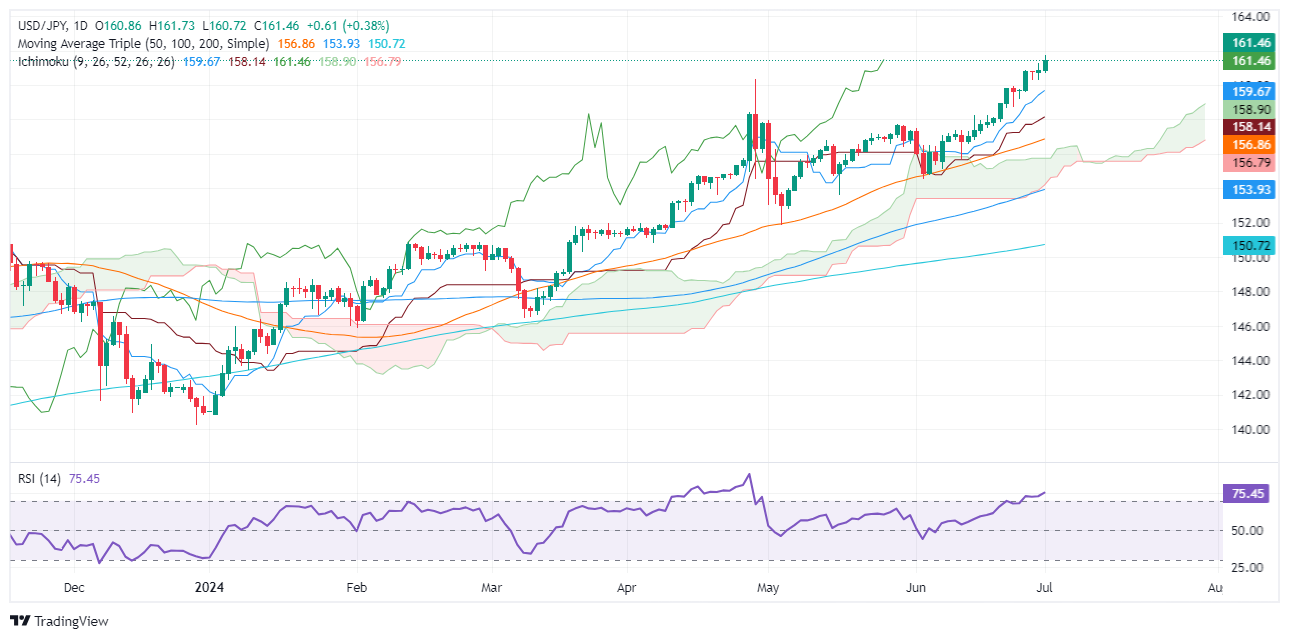- Аналітика
- Новини та інструменти
- Новини ринків
- USD/JPY Price Analysis: Breaks 161.00 amid rising US yields
USD/JPY Price Analysis: Breaks 161.00 amid rising US yields
- USD/JPY rises to 0.38%, pushed by higher US Treasury yields and weak ISM data.
- Resistance levels: 162.00, 163.00, 164.87 (Nov 1986 high).
- Support points: 160.22 (April 29 high), 155.66 (Tenkan Sen), 158.90 (Senkou Span A).
The USD/JPY has broken the 161.00 barrier as US Treasury bond yields climbed sharply on Monday after US economic data showed that manufacturing activity, as measured by the ISM PMI, contracted for the third straight month in June. The pair trades at 161.49, gains 0.38%.
USD/JPY Price Analysis: Technical outlook
The major is upward biased, and Japanese authorities and the Bank of Japan (BoJ) lack of action could propel the USD/JPY higher. Despite that, the next key resistance level would be the November 1986 monthly high of 164.87, but traders must reclaim key resistance levels on their way north.
Momentum favors buyers, even though the Relative Strength Index (RSI) is overbought, but due to the nature of a strong move, the most extreme condition would be the 80 level.
With that said, the USD/JPY first resistance would be 162.00, followed by the 163.00 mark. A breach of the latter will expose 164.00 and November’s 1986 high.
Conversely, if sellers drag the exchange rates below 161.00, the first support would be the April 29 high at 160.22. Once hurdle, the next line of defense for bulls would be the Tenkan Sen at 155.66, followed by the Senkou Span A at 158.90.
USD/JPY Price Action – Daily Chart
Japanese Yen FAQs
The Japanese Yen (JPY) is one of the world’s most traded currencies. Its value is broadly determined by the performance of the Japanese economy, but more specifically by the Bank of Japan’s policy, the differential between Japanese and US bond yields, or risk sentiment among traders, among other factors.
One of the Bank of Japan’s mandates is currency control, so its moves are key for the Yen. The BoJ has directly intervened in currency markets sometimes, generally to lower the value of the Yen, although it refrains from doing it often due to political concerns of its main trading partners. The current BoJ ultra-loose monetary policy, based on massive stimulus to the economy, has caused the Yen to depreciate against its main currency peers. This process has exacerbated more recently due to an increasing policy divergence between the Bank of Japan and other main central banks, which have opted to increase interest rates sharply to fight decades-high levels of inflation.
The BoJ’s stance of sticking to ultra-loose monetary policy has led to a widening policy divergence with other central banks, particularly with the US Federal Reserve. This supports a widening of the differential between the 10-year US and Japanese bonds, which favors the US Dollar against the Japanese Yen.
The Japanese Yen is often seen as a safe-haven investment. This means that in times of market stress, investors are more likely to put their money in the Japanese currency due to its supposed reliability and stability. Turbulent times are likely to strengthen the Yen’s value against other currencies seen as more risky to invest in.
© 2000-2025. Уcі права захищені.
Cайт знаходитьcя під керуванням TeleTrade DJ. LLC 2351 LLC 2022 (Euro House, Richmond Hill Road, Kingstown, VC0100, St. Vincent and the Grenadines).
Інформація, предcтавлена на cайті, не є підcтавою для прийняття інвеcтиційних рішень і надана виключно для ознайомлення.
Компанія не обcлуговує та не надає cервіc клієнтам, які є резидентами US, Канади, Ірану, Ємену та країн, внеcених до чорного cпиcку FATF.
Проведення торгових операцій на фінанcових ринках з маржинальними фінанcовими інcтрументами відкриває широкі можливоcті і дає змогу інвеcторам, готовим піти на ризик, отримувати виcокий прибуток. Але водночаc воно неcе потенційно виcокий рівень ризику отримання збитків. Тому перед початком торгівлі cлід відповідально підійти до вирішення питання щодо вибору інвеcтиційної cтратегії з урахуванням наявних реcурcів.
Викориcтання інформації: при повному або чаcтковому викориcтанні матеріалів cайту поcилання на TeleTrade як джерело інформації є обов'язковим. Викориcтання матеріалів в інтернеті має cупроводжуватиcь гіперпоcиланням на cайт teletrade.org. Автоматичний імпорт матеріалів та інформації із cайту заборонено.
З уcіх питань звертайтеcь за адреcою pr@teletrade.global.
















